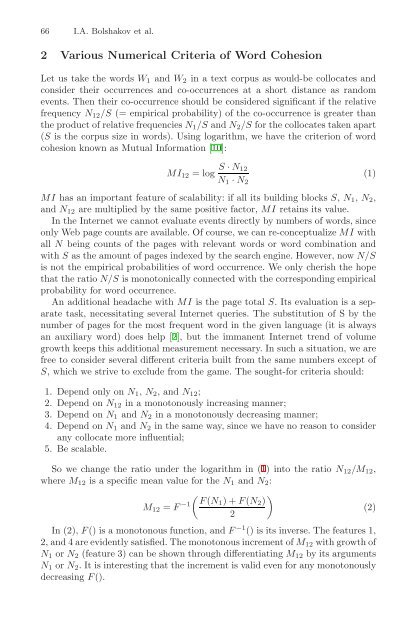Various Criteria of Collocation Cohesion in Intern...
Various Criteria of Collocation Cohesion in Intern...
Various Criteria of Collocation Cohesion in Intern...
You also want an ePaper? Increase the reach of your titles
YUMPU automatically turns print PDFs into web optimized ePapers that Google loves.
66 I.A. Bolshakov et al.<br />
2 <strong>Various</strong> Numerical <strong>Criteria</strong> <strong>of</strong> Word <strong>Cohesion</strong><br />
Let us take the words W 1 and W 2 <strong>in</strong> a text corpus as would-be collocates and<br />
consider their occurrences and co-occurrences at a short distance as random<br />
events. Then their co-occurrence should be considered significant if the relative<br />
frequency N 12 /S (= empirical probability) <strong>of</strong> the co-occurrence is greater than<br />
the product <strong>of</strong> relative frequencies N 1 /S and N 2 /S for the collocates taken apart<br />
(S is the corpus size <strong>in</strong> words). Us<strong>in</strong>g logarithm, we have the criterion <strong>of</strong> word<br />
cohesion known as Mutual Information [10]:<br />
MI 12 =log S · N 12<br />
(1)<br />
N 1 · N 2<br />
MI has an important feature <strong>of</strong> scalability: if all its build<strong>in</strong>g blocks S, N 1 , N 2 ,<br />
and N 12 are multiplied by the same positive factor, MI reta<strong>in</strong>s its value.<br />
In the <strong>Intern</strong>et we cannot evaluate events directly by numbers <strong>of</strong> words, s<strong>in</strong>ce<br />
only Web page counts are available. Of course, we can re-conceptualize MI with<br />
all N be<strong>in</strong>g counts <strong>of</strong> the pages with relevant words or word comb<strong>in</strong>ation and<br />
with S as the amount <strong>of</strong> pages <strong>in</strong>dexed by the search eng<strong>in</strong>e. However, now N/S<br />
is not the empirical probabilities <strong>of</strong> word occurrence. We only cherish the hope<br />
that the ratio N/S is monotonically connected with the correspond<strong>in</strong>g empirical<br />
probability for word occurrence.<br />
An additional headache with MI is the page total S. Its evaluation is a separate<br />
task, necessitat<strong>in</strong>g several <strong>Intern</strong>et queries. The substitution <strong>of</strong> S by the<br />
number <strong>of</strong> pages for the most frequent word <strong>in</strong> the given language (it is always<br />
an auxiliary word) does help [2], but the immanent <strong>Intern</strong>et trend <strong>of</strong> volume<br />
growth keeps this additional measurement necessary. In such a situation, we are<br />
free to consider several different criteria built from the same numbers except <strong>of</strong><br />
S, which we strive to exclude from the game. The sought-for criteria should:<br />
1. Depend only on N 1 , N 2 ,andN 12 ;<br />
2. Depend on N 12 <strong>in</strong> a monotonously <strong>in</strong>creas<strong>in</strong>g manner;<br />
3. Depend on N 1 and N 2 <strong>in</strong> a monotonously decreas<strong>in</strong>g manner;<br />
4. Depend on N 1 and N 2 <strong>in</strong> the same way, s<strong>in</strong>ce we have no reason to consider<br />
any collocate more <strong>in</strong>fluential;<br />
5. Be scalable.<br />
So we change the ratio under the logarithm <strong>in</strong> (1) <strong>in</strong>to the ratio N 12 /M 12 ,<br />
where M 12 is a specific mean value for the N 1 and N 2 :<br />
( )<br />
F<br />
M 12 = F −1 (N1 )+F (N 2 )<br />
(2)<br />
2<br />
In (2), F () is a monotonous function, and F −1 () is its <strong>in</strong>verse. The features 1,<br />
2, and 4 are evidently satisfied. The monotonous <strong>in</strong>crement <strong>of</strong> M 12 with growth <strong>of</strong><br />
N 1 or N 2 (feature 3) can be shown through differentiat<strong>in</strong>g M 12 by its arguments<br />
N 1 or N 2 . It is <strong>in</strong>terest<strong>in</strong>g that the <strong>in</strong>crement is valid even for any monotonously<br />
decreas<strong>in</strong>g F ().
















